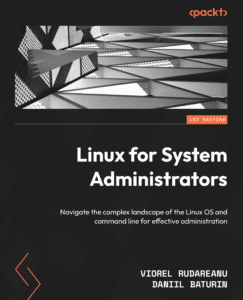Viorel Rudareanu is the author of Linux for System Administrators we got the chance to sit down with him and find out more about his experience of writing with Packt.
Q: How did you become an author for Packt? Tell us about your journey. What was your motivation for writing this book?
Viorel: I’ve been approached on LinkedIn over a year ago to write a book. Initially I wasn’t sure about writing a book, but after several re-considerations I decided to go further, main motivation being to share knowledge with other people and help them to step in Linux world.
Q: What is the name of your book?
Viorel: Linux for System Administrators.
Q: What kind of research did you do, and how long did you spend researching before beginning the book?
Viorel: It was more to create a content index for the book, one that was in place, all was clear.
Q: What key takeaways do you want readers to come away with from the book?
Viorel: Here are key takeaways that readers should come away with after reading such a book: 1. Understanding of Linux Architecture: Readers should have a clear understanding of the Linux operating system’s architecture, including the kernel, file system, and user space components.
2. Command Line Proficiency: Proficiency in the Linux command line is crucial. Readers should be comfortable with essential commands for file management, process control, system configuration, and troubleshooting.
3. System Installation and Configuration: Readers should know how to install and configure Linux on various hardware and virtualized environments. This includes partitioning disks, setting up network configurations, and selecting appropriate software packages during installation.
4. User and Group Management: A Linux system administration book should cover user and group management, including adding and removing users, modifying user permissions, and managing password policies.
5. File System Management: Understanding Linux file systems (e.g., ext4) and how to manage files and directories, set permissions, and handle disk-related tasks like formatting and mounting drives is essential.
6. Package Management: Proficiency with the package manager specific to the Linux distribution being used (e.g., apt for Debian-based systems, yum for Red Hat-based systems) is crucial. Readers should know how to install, update, and remove software packages.
7. Security Practices: Readers should learn about Linux security practices, including configuring firewalls, managing user permissions, using encryption, and securing services. Knowledge of best practices to protect the system from external threats is vital.
8. Networking and Services: Understanding networking concepts, configuring network interfaces, and managing network services (e.g., DNS, DHCP, SSH) is essential for system administration.
9. Process and System Monitoring: Readers should be able to monitor system performance, identify resource bottlenecks, and troubleshoot system issues. Knowledge of tools like top, htop, and ps is valuable.
10. Backup and Recovery: Learning how to create and execute backup strategies is crucial. Readers should know how to recover from system failures and data loss efficiently.
11. Scripting and Automation: Proficiency in shell scripting (e.g., Bash) is important for automating routine tasks and system maintenance. Readers should be able to write scripts to streamline administrative processes.
12. Virtualization and Containers: Understanding virtualization technologies (e.g., VirtualBox, KVM) and containerization (e.g., Docker) is becoming increasingly important in modern Linux administration.
13. Log Analysis and Troubleshooting: Readers should be able to analyze system logs, diagnose issues, and apply troubleshooting techniques to resolve problems efficiently.
14. Performance Tuning: Knowledge of techniques to optimize system performance, including kernel tuning, resource allocation, and application-specific optimizations, is valuable. Documentation and Best Practices: System administrators should practice good documentation habits and adhere to best practices in system administration, ensuring clear records of configurations and changes.
15. Compliance and Regulations: Depending on the environment, understanding compliance requirements and regulations (e.g., GDPR, HIPAA) relevant to system administration is crucial.
16. Continuous Learning: Linux is a dynamic ecosystem. Readers should come away with a mindset of continuous learning and staying updated with the latest tools and practices in the Linux administration field.
Q: Can you share any blogs, websites and forums to help readers gain a holistic view of the tech they are learning?
Viorel: N/A.
Q. Did you face any challenges during the writing process? How did you overcome them?
Viorel: The biggest enemy was time. Hard to overcome this, but I tried to add a little bit of content after working hours or weekends.
Q. How would you describe your author journey with Packt? Would you recommend Packt to aspiring authors?
Viorel: It was a very long journey but all the people were always very helpful. Definitely would recommend Packt to aspiring authors.
Q. Why should readers choose this book over others already on the market? How would you differentiate your book from its competition?
Viorel: In summary, this book differentiates itself from the competition by offering a beginner-friendly approach that emphasizes simplicity, practicality, and ease of understanding. It empowers newcomers to the subject with accessible language, real-world examples, step-by-step guidance, visuals and hands-on practice. Our goal is to make learning enjoyable and effective, ensuring that readers come away with a strong grasp of the subject matter.
Q. What is/are your specialist tech area(s)?
Viorel: My specialist tech areas are Linux and DevOps.
Q. What advice would you give to readers jumping into this technology? Do you have any top tips?
Viorel: Absolutely! jumping into Linux technology can be an exciting and rewarding journey. Here are some top tips and advice for newcomers to Linux:
1. Start with a User-Friendly Distro: If you’re new to Linux, consider starting with a user-friendly distribution (distro) like Ubuntu, Linux Mint, or Fedora. These distros are known for their ease of use and extensive online support communities.
2. Learn the Basics of the Command Line: The command line is a powerful tool in Linux. Invest time in learning basic commands and concepts like navigating directories (cd), listing files and directories (ls), copying (cp) and moving (mv) files, and text editing with tools like nano or vim.
3. Understand the File System: Linux has a different file system structure compared to Windows. Learn about the root directory (/), system directories, and user directories like /home.
4. Package Management: Get familiar with your distro’s package manager (e.g., apt for Debian-based systems, yum for Red Hat-based systems). This is how you install, update, and remove software on Linux.
5. Learn About Permissions: Linux has a robust permission system. Understand how file permissions work using commands like chmod and chown.
6. Practice Virtualization: Set up virtual machines using tools like VirtualBox or VMware Player to experiment with different Linux distributions and configurations without affecting your main system.
7. Backup Your Data: Regularly back up your important data. Linux offers various backup tools, and cloud storage options like Dropbox and Google Drive work well too.
8. Join the Linux Community: Linux has a strong online community. Participate in forums like Stack Exchange, Reddit’s r/linux, and the official forums of your chosen distribution. Don’t hesitate to ask questions when you’re stuck.
9. Explore the Terminal: Don’t shy away from using the terminal. Many Linux tutorials and solutions are written for the command line, and it can be more efficient for certain tasks.
10. Learn Shell Scripting: If you plan to use Linux for automation or system administration, consider learning a scripting language like Bash. It’s a valuable skill for automating tasks.
11. Stay Updated: Regularly update your system to ensure you have the latest security patches and software updates. Use the package manager to do this.
12. Read Documentation: Linux has extensive documentation available online. Learn to navigate and search documentation effectively. The man command is your friend for accessing manual pages.
13. Experiment Safely: Don’t be afraid to experiment, but be cautious. Before making significant changes to your system, research and backup data. Use virtual machines for risky experiments.
14. Master the Package Manager: Understanding how your distribution’s package manager works is crucial. Learn how to install, update, and remove software packages using it.
15. Be Patient and Persistent: Linux has a learning curve, especially if you’re new to the command line and open-source software. Be patient with yourself, and don’t be afraid to keep trying and learning from your mistakes. Enjoy your Linux journey!
Q. What’s your take on the technologies discussed in the book? Where do you see these technologies heading in the future?
Viorel: Common technologies discussed in Linux for system administrators typically include: Linux Operating System: Understanding the Linux kernel, command-line interface, file system structure, and basic system administration tasks are fundamental for system administrators.
Shell Scripting: Scripting languages like Bash are vital for automating system tasks and managing configurations.
Package Management: Learning how to manage software packages using tools like APT, Yum, or Zypper is essential for keeping systems up to date.
Networking: Familiarity with networking concepts, configuration, and troubleshooting is crucial, including tools like iptables, systemd-networkd, or NetworkManager.
Security: Knowledge of security practices, user management, file permissions, firewalls, and intrusion detection systems is necessary to secure Linux systems.
Monitoring and Logging: Tools used for monitoring system health and analyzing logs.
Automation and Configuration Management: Technologies like Ansible, Puppet, and Chef help automate repetitive tasks and ensure system consistency.
As for the future of these technologies:
Containerization and Orchestration: Technologies like Docker and Kubernetes are expected to continue growing in importance as containerization and microservices become standard practices in software development and deployment.
Cloud Computing: The trend toward cloud-based infrastructure is likely to persist. More Linux system administrators will need to understand cloud platforms and manage hybrid or multi-cloud environments.
Automation: The need for automation will only increase. Tools like Ansible and Terraform will continue to play a significant role in managing and provisioning infrastructure.
Security: With the increasing importance of cybersecurity, Linux system administrators will need to stay up to date with the latest security threats and best practices to protect their systems.
Machine Learning and AI: These technologies may find applications in system administration for predictive maintenance, anomaly detection, and automated decision-making.
Edge Computing: As edge computing becomes more prevalent, Linux administrators will be tasked with managing distributed systems and edge devices. It’s important for system administrators to adapt to these evolving trends by continually updating their skills and knowledge to remain effective in their roles. Additionally, the open-source nature of Linux means that the ecosystem will continue to evolve and introduce new tools and technologies to improve system administration.
Q. How did you organize, plan, and prioritize your work and write the book?
Viorel: Writing a book is a complex and time-consuming process, so effective organization and planning are essential. Here’s a step-by-step guide i followed:
Define Your Purpose and Audience: Determine the purpose of your book. What message or story do you want to convey? Identify your target audience. Who will be reading your book, and what do they expect from it?
Set Clear Goals: Establish specific, measurable, achievable, relevant, and time-bound (SMART) goals for your book project. How many words or pages do you want to write, and by when?
Create a Writing Schedule: Decide when and how often you will write. Consistency is key, so establish a writing routine that works for you. Consider setting daily or weekly word count targets to track your progress.
Research and Outlining: Conduct any necessary research to gather information and ideas for your book. Create an outline or structure for your book. This can be a chapter-by-chapter breakdown or a more general roadmap.
Prioritize Tasks: Break down the writing process into smaller tasks, such as research, writing, editing, and proofreading. Prioritize tasks based on deadlines and importance.
Set Realistic Deadlines: Establish clear deadlines for completing each phase of your book, from the first draft to final revisions.
Writing and Editing: Start writing according to your outline, focusing on one section or chapter at a time. Don’t get bogged down with self-editing during the initial writing phase. Complete your first draft before making extensive edits.
Seek Feedback: After completing your first draft, share it with beta readers, critique partners, or writing groups to get feedback.
Revise and Polish: Use the feedback received to revise and improve your manuscript. Pay attention to clarity, structure, and the overall flow of your book.
Q. What are your favorite tech journals? How do you keep yourself up to date on tech?
Viorel: LinkedIn has been my favorite – esp. since the whole tech community is there. Wired, Forbes, The Verge and ZDNet (among others) help me stay up to date on tech.
Q. Would you like to share your social handles? If so, mention them below.
Viorel: Sure. Here you go:
LinkedIn: https://www.linkedin.com/in/viorel-rudareanu-4639b08/.
Q: What is that one writing tip that you found most crucial and would like to share with aspiring authors?
Viorel: Don’t rush, read and read it again.
You can find Viorel’s book on Amazon by following this link: Please click here









